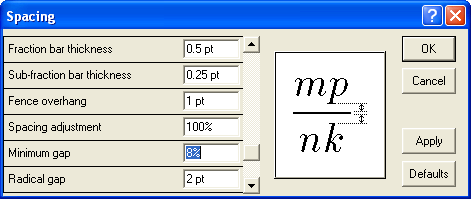Written by Allen Wyatt (last updated September 26, 2019)
This tip applies to Word 97, 2000, 2002, and 2003
The Equation Editor allows you to specify the minimum spacing between the numerator and denominator of an equation and the division bar used between them. In Equation Editor terminology, this spacing is called the gap. You specify the gap spacing as a percentage of the normal character height. You can set this value as follows:

Figure 1. The Spacing dialog box.
WordTips is your source for cost-effective Microsoft Word training. (Microsoft Word is the most popular word processing software in the world.) This tip (945) applies to Microsoft Word 97, 2000, 2002, and 2003.

Do More in Less Time! An easy-to-understand guide to the more advanced features available in the Microsoft 365 version of Word. Enhance the quality of your documents and boost productivity in any field with this in-depth resource. Complete your Word-related tasks more efficiently as you unlock lesser-known tools and learn to quickly access the features you need. Check out Microsoft 365 Word For Professionals For Dummies today!
Ever have the problem of your document printing different characters than what appears on the screen? There are several ...
Discover MoreIf you are using matrices in your equations, you can add lines to a matrix by applying this tip.
Discover MoreThe Equation Editor is a great way to add an professional-looking equation to your document. It allows you to modify many ...
Discover MoreFREE SERVICE: Get tips like this every week in WordTips, a free productivity newsletter. Enter your address and click "Subscribe."
There are currently no comments for this tip. (Be the first to leave your comment—just use the simple form above!)
Got a version of Word that uses the menu interface (Word 97, Word 2000, Word 2002, or Word 2003)? This site is for you! If you use a later version of Word, visit our WordTips site focusing on the ribbon interface.
Visit the WordTips channel on YouTube
FREE SERVICE: Get tips like this every week in WordTips, a free productivity newsletter. Enter your address and click "Subscribe."
Copyright © 2025 Sharon Parq Associates, Inc.
Comments